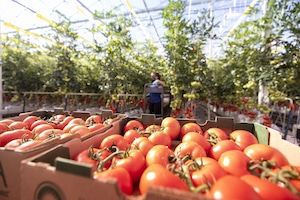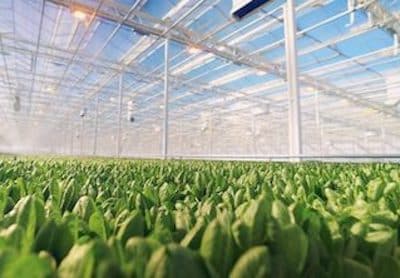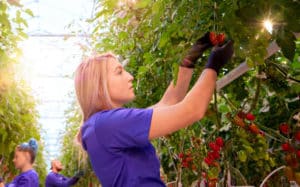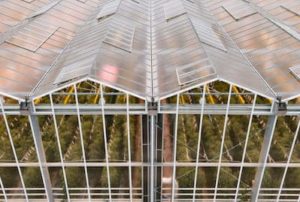 “How do we feed more people with less land and less environmental impacts?” is a question that has kept agricultural-minded folks up at night for years. In the past five years, coupled with recent pandemic-based food supply disruptions and the American quest for year-round fresh (especially fruits and vegetables), the challenge to look beyond traditional growing environments for answers has intensified. From urban settings to the center of Appalachia in Kentucky, we have entered the era of controlled environment agriculture (CEA) or indoor farms. It’s a century old practice now fueled with space age technology.
“How do we feed more people with less land and less environmental impacts?” is a question that has kept agricultural-minded folks up at night for years. In the past five years, coupled with recent pandemic-based food supply disruptions and the American quest for year-round fresh (especially fruits and vegetables), the challenge to look beyond traditional growing environments for answers has intensified. From urban settings to the center of Appalachia in Kentucky, we have entered the era of controlled environment agriculture (CEA) or indoor farms. It’s a century old practice now fueled with space age technology.
From Caesar to Kentucky
Whether it’s vertical farms, indoor farms or greenhouses, all are examples of CEA, which is defined as a combined system of engineering technology and horticultural techniques that promote optimal quality and efficient production of crops in a controlled environment.1 Even though the development of CEA companies is relatively new in the U.S., CEA is not. The earliest recorded CEA production occurred between 14-37 AD when Caesar’s doctor ordered a cucumber a day for his good health. Hence, movable plant beds, covered with transparent stone to capture the warmth of the winter sun or moved indoors on bad weather days, became the foundation of today’s advanced systems.1
Building on Kentucky Ag Culture: AppHarvest
As a sixth-generation Kentucky farm owner, I value the long-standing agriculture culture of my home state yet celebrate the addition of AppHarvest, a CEA that has promise to maximize the state’s natural resources and geographical location, and increase produce production within the Midwest. Unlike vertical farming operations that must build up, creating stacked layers of plants in limited urban spaces, AppHarvest indoor farms range from 60 acres of tomatoes to the newly opened 30-acre berry farm and 15-acre salad green entity. These are crops that the eastern Appalachian region of Kentucky would not be able to grow in a traditional field beyond a two to three-month period. Additionally, these high-tech farms use natural resources rather than relying exclusively on artificial light or public water as often required by urban located vertical farms.
 With the AppHarvest system, sunshine and rainwater are captured on “Venlo-style” greenhouse roofs made of special glass that diffuses the light to help ensure each plant gets its fair share. With the changes in climate, abundant rainfall in this Kentucky region provides adequate water supplies. AppHarvest uses about 90% less water than traditional agriculture fields due to a closed-loop irrigation system. The system also significantly minimizes the amount of nutrients needed as compared to an open-field farm, reducing greenhouse gas emissions and preventing agricultural runoff pollution. Sunshine is the main source of light for the plants, and the indoor farm was built in an east-west position to capture as much solar energy as possible. When needed, a hybrid array of traditional grow lights and LEDs, which are 40% more efficient, are used.
With the AppHarvest system, sunshine and rainwater are captured on “Venlo-style” greenhouse roofs made of special glass that diffuses the light to help ensure each plant gets its fair share. With the changes in climate, abundant rainfall in this Kentucky region provides adequate water supplies. AppHarvest uses about 90% less water than traditional agriculture fields due to a closed-loop irrigation system. The system also significantly minimizes the amount of nutrients needed as compared to an open-field farm, reducing greenhouse gas emissions and preventing agricultural runoff pollution. Sunshine is the main source of light for the plants, and the indoor farm was built in an east-west position to capture as much solar energy as possible. When needed, a hybrid array of traditional grow lights and LEDs, which are 40% more efficient, are used.
Even though these entitles are referenced as indoor farms, the AppHarvest technology team describes its Morehead, Kentucky, flagship operation as a “60-acre robot,” with more than 300 micro-climate sensors that can automatically control the environment for conditions such as temperature, humidity and light.
A Solution for “Local” Fresh?
It’s reality! Only one in 10 of us in the U.S. consume the recommended daily servings of fruits and vegetables, but our desire for year-round fresh produce continues to rise. In fact, two-thirds of our produce is imported with Mexico being our biggest supplier. CEAs like AppHarvest view their future as an opportunity to increase the production of domestically grown fruits and vegetables, especially in geographic locations, like Kentucky, that are within a day’s drive of 70% of the U.S. population but would not be a year-round source of produce without a climate-controlled environment option. AppHarvest replants their crops in the summer when open-field crops start to produce and then harvest in the fall when the region’s growing season ends.

More Than One Solution to Feed the World
Finding solutions to feed more people in a sustainable manner creates new opportunities and, at times, conflicts. When headlines tout the future of CEA as a solution, others question its viability or impact on more conventional farming methods. The AppHarvest team, when asked about its impact on traditional agriculture, states, “CEA still is a drop in the bucket compared to overall food production. We don’t see CEA as a solution to row crop production in the near to mid-future. However, the new CEA options can help to increase domestic produce production that is affordable and accessible and begin building a more reliable domestic food system and food security. We advocate for CEA being the third wave of sustainable infrastructure — following the leads of renewable energy and electric vehicle adoption.”

Notes:
1. AppHarvest team members I met earlier this year contributed to the written content of this article. No monetary relationship or conflict of interest exist.
2. All photos courtesy of AppHarvest. Used by permission.
References
1. Mattson, Neil. Controlled Environment Agriculture. Cornell University College of Agriculture & Life Sciences.
2. “Feasibility Study of a Controlled Environment Agriculture Ecosystem in Kentucky,” by P. Ravensbergen, M.A. Williams, B.J. Webb, W.G. Owen, T.A. Woods, L.H. Aramyan, G.M. Splinter and Y.N. de Valk, 2022.
